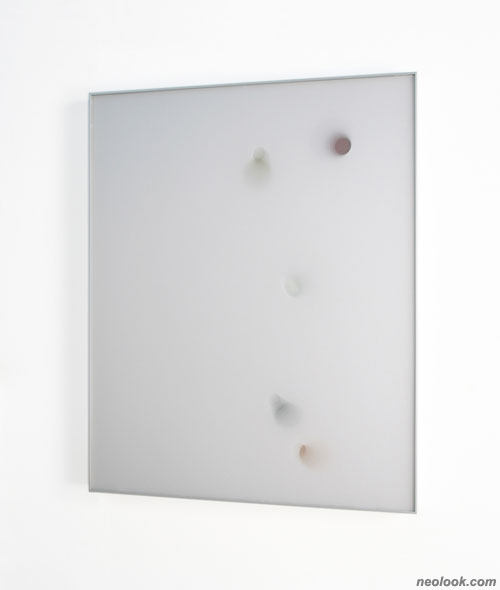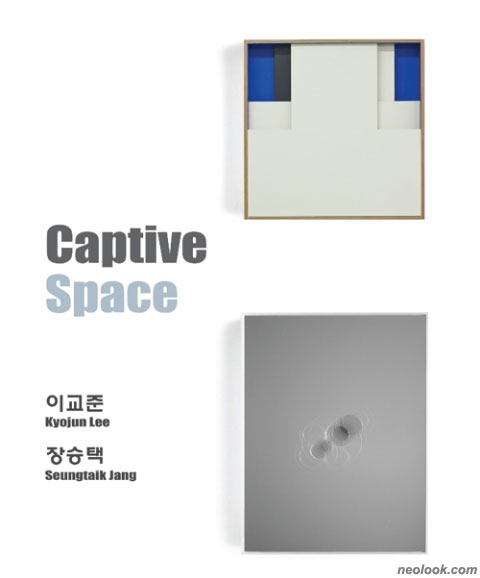- ● homepage
- ● archives
- ● restoration
- ● books
- ● big banners
- ● post board
- ■ neo's search
- ■ about us
- ■ 게재방법 안내
- 개인정보처리방침

- [email protected]
- Tel. 02_335_7922
- Fax. 02_335_7929
- 10:00am~04:30pm
- 월요일~금요일
- 3/3(월) 대체공휴일

Captive Space
이교준_장승택展 2011_0209 ▶ 2011_0303 / 월요일 휴관
초대일시_2011_0209_수요일_06:00pm
갤러리 스케이프 기획展
관람시간 / 화~금요일_10:00am∼07:00pm / 토~일요일_10:00am∼06:00pm / 월요일 휴관
갤러리 스케이프 GALLERY skape 서울 종로구 가회동 72-1번지 Tel. +82.2.747.4675 www.skape.co.kr
포획된 공간으로의 매혹된 시선 ● 회화의 고유한 특성을 주창하는 형식주의적 태도가 진부해진 후, 회화는 타매체와의 결합을 통해 혼종의 상태로 다양하게 전개돼 왔다. 그러함에도 불구하고 고유한 회화성에 대한 탐구를 지속하며 새로운 가능성들을 제시하고 있는 작가들이 있는데, 이번 전시에서 소개하게 된 이교준, 장승택은 1990년 초반부터 회화성에 대한 근원적 태도를 견지해오며 변화를 모색해오고 있다. 두 작가는 화면에 머무는 주술적 환영을 배재하고 평면성 그 자체를 물성, 지각과 관계하는 빛과 색 등 기본적 성질을 통해 실험하며 회화의 담론을 각기 진화시켜 왔다. ● 사각의 형식적 틀을 고수한 가운데, 회화를 근원적 환경으로서 제시해온 두 작가의 근작이 프레임 구조를 완벽하게 갖춘 박스형에 레이어화 된 공간적 특성을 지니는 점은 특이할 만한 사항이다. 이교준은 베니어 합판으로 제작한 나무 상자 안에서 직교하는 색면들의 레이어로, 장승택은 폴리에스테르 필름을 겹겹이 쌓아 구멍을 컷팅한 '폴리드로잉'으로 회화의 구조를 중층화하고 있다. 이러한 두 작가의 근작에서 착안된 『Captive Space』전은 '포획된 공간'이라는 의미를 함축하며, 프레임 속으로 공간을 사로잡고 있는 두 작가의 화면 구조에 주목한 것이다.

- 이교준_Void-c_베니어 합판에 아크릴채색_각 90×60×15cm_2011
화면에 포획된 시선의 두께 - 이교준 ● 이교준의 작품은 평면적 구조를 수직․수평의 선을 통해 엄격하고도 절제된 모습으로 다룬다. 화면을 분할하는 그리드는 선으로부터 면을 그리고 면으로부터 공간의 속성을 낱낱이 밝히며 화면에 얽힌 차원을 총괄적으로 제시한다. 박스형의 프레임 구조 안에 켜들로 드러난 면들은 기하학성으로 인해 미니멀하게 구획된 건축구조를 보는 듯하다. 하지만 이러한 측면은 공간적 구조보다는 오히려 평면적 구조를 밝히려는 시도로 접근해야 할 것이다. 이는 박스형의 두께를 지닌 근작 이전에 작가가 선보였던 평면 작품들에서 찾을 수 있다. 그리드만이 남은 화면에서조차 평면은 2차원의 구조 그 자체로 존재하지 않는다. 백색의 화면은 텅 빈 공간으로 환영의 잔영을 남긴다. 또한 그리드가 겹쳐져 있는 작품은 상이한 색으로부터 화면의 위계를 부여하는 눈속임 효과를 가져 온다.

- 이교준_Void-c_베니어 합판에 아크릴채색_50×50×15cm_2011
이렇듯 평면을 다루던 작가가 우연한 기회에 손수 제작하게 된 박스형의 공간은 순수하다고 믿어 의심치 않던 시각 구조의 자가당착을 현실화된 공간 속으로 분해하여 보여준다. 직교하는 색면들 사이에서 형성된 환영적 공간, 다시 말해 선이 면과 관계하는 순간은 평면적 시각에 잠재된 공간이 드러나는 순간이다. 이는 회화의 관념적이고 개념화된 평면성을 그리드를 통해 실 공간 속으로 분할하는 것이다. 이리하여 박스 시리즈는 더 이상 분할이 불가능한 2차원의 화면 위에 잠재된 시선의 두께는 밝히는 것과 관계된다. 이는 보이지 않는 공간에 존재하는 수많은 켜들을 가시화하는 작업으로, 화면의 기저에 작용하는 시선의 두께를 다룸으로써 가시적 영역을 표면화 한다.

- 이교준_Void-c_베니어 합판에 아크릴채색_100×100×17cm_2010

- 이교준_Void-c_베니어 합판에 아크릴채색_60×42.4×15cm_2010
켜의 공간에 포획된 비물질적 세계 - 장승택 ● 겨울의 시린 공기로부터 얼어붙은 호수의 수면을 연상시키는 장승택의 작업은 그 화면의 군데군데 작은 구멍들이 시선을 매혹시킨다. 작가가 '폴리드로잉(Poly-Drawing)'이라 개념화한 근작들은 반투명한 폴리에스테르 필름을 하나씩 쌓아 알루미늄 패널로 밀봉한 것이다. 엄밀히 말하면, 반투명한 물성과 프레임의 구조를 통해 빛과 어둠이라는 비물질적 속성을 프레임 안에 가둔 것이다. 녹아내린 빙판 사이로 드러난 심해의 어둠을 좇듯, 그곳엔 함몰된 구멍들이 있다. 어슴푸레한 화면에 드러난 미지의 공간 속으로 포획된 시선은 구멍을 좇아, 밖으로 나갈 줄을 모른다. 한 켜 한 켜, 중첩된 면들을 따라 수렴된 시선은 어느새 켜 너머의 공간을 향한다.

- 장승택_Untitled-Poly drawing G18_P.E.T 필름_60×45cm_2010

- 장승택_Untitled-Poly drawing G10_P.E.T 필름_60×45cm_2010
화면의 2차원적 구조에 한정된 물리적 영역은 불투명한 켜의 공간으로부터 물리적 한계를 거스른다. 또한 함몰된 구멍을 향해 매혹된 시선은 현실의 시간성을 잃어버리고, 과거의 자취를 따라 시간을 역류한다. 이러한 시각과정은 평면적 구조에서 부재하는 장면으로, 그의 작업은 보이지 않는 시간과 공간을 시각구조로서 가시화한다. 절제된 감성과 이성의 뒷면에서 억압된 근원적 장면은 한없이 뒤로 뒷걸음치나, 이를 포획하는 구조가 그곳에 있다. 이 심연한 영역은 켜들로 표면화됨으로써 마침내 의식의 세계로 드러난다. 근원을 거슬러 표면으로 올라가는 순간이다. 이 과정에서 어둠은 스스로를 빛으로 발하며 켜와 켜를 거쳐 반투명한 화면으로 다시 통합된다. 이는 의식과 무의식 사이에서 보이지 않은 미지의 영역을 표면화한다. 겹겹이 쌓인 켜들을 관통하는 시선은 시간을 거스른다. 그리고 공간을 건너간다. 켜와 켜를 따라 하강과 상승을 반복하는, 그 적층의 연속성은 물질과 정신의 영역을 모두 관통하여 흐른다. 그리하여 도달한 곳은 개개인의 내면 깊숙이 잠긴 작은 심연이자 이 세계의 심연들이다.

- 장승택_Untitled-Poly drawing C8_P.E.T 필름_100×80cm_2010
두 작가는 프레임이라는 형식적 틀을 기반으로 하여 2차원적 표면에 존재하는 수많은 시선의 켜들을 공간화 하여 접근하고 있다. 이들의 작품이 전제 조건으로 고수하는 프레임은 켜의 공간을 통해 확장되며, 이는 다시 역으로 공간을 프레임화 하는 반동의 시각 작용을 일으킨다. 이렇게 포획된 공간으로 향하는 시선은 분리, 전이, 통합의 과정을 거쳐 평면의 구조를 물성, 빛, 색 등 근본적 요소로 분화하는 동시에 재통합시킨다. 그러한 과정에서 회화를 지각하는 새로운 가능성들이 켜의 공간을 통해 제시되며, 그리하여 이들의 작업은 새로운 추상화의 지평을 평면적 조건을 넘어서며 발생시키고 있다. 프레임으로부터 공간적 측면을 다시 평면성으로 환원시키고 있는 두 작가의 작품은 고유한 회화의 영역을 평면과 입체라는 형식적 경계를 넘나들으며 현상의 지층들을 표면화한다. 물질로부터 정신으로, 언어로부터 비언어로, 가시성으로부터 비가시적 세계로 시선을 포획하는 두 작가의 화면은 단절된 세계 사이를 매개하며, 순수한 시각성이 이끄는 초월적 공간을 보여준다. ■ 심소미

- 장승택_Untitled-Poly drawing C6_P.E.T 필름_100×80cm_2010
Captive space with an enchanted viewpoint ● Since it is considered to be outdated to treat the genre of painting by the formalistic approach emphasizing its unique attributes, painting has been developed in various ways through the process of fusing with other media, placing itself in a hybrid state. Even so, there are still artists who keep bringing out new possibilities of paintings through the continuous research on this medium. Kyojun Lee and Seungtaik Jang, introduced in this exhibition, are the artists who keep exploring new ways of painting with their continuous devotion to the fundamental perspective on the genre since the early 1990. These two artists have been separately arousing discourses on the genre of painting. Excluding painting's capacity of creating illusions on screen, they have experimented the flat surface through its basic characteristics such as materiality, light and color. ● Holding on to formal frames, they treat painting as an environment. Thus, it is interesting to point out that their new works involve a spatial aspect created by the layers within a perfectly framed box. While Kyojun Lee creates boxes in plywood where cross the layers of color planes orthogonally, Seungtaik Jang composes 'Poly-Drawing', the stack of layers of polyester films where holes are punched. Through different methods, both of them gain accumulated structures within a painting. The exhibition entitled as 'Captive Space' is based on the structures of two artists' paintings which enclose space within a frame. Thickness enclosed within the screen - Kyojun Lee ● Kyojun Lee creates strict and restrained surfaces by using vertical and horizontal lines. The grid dividing the screen reveals a plane from lines and a space from planes, suggesting multiple dimensions in block while disclosing intrinsic properties of space. The geometric planes exposed as layers within the frame structure conjure up a minimal architectural space. However, this aspect seems to be an attempt to expose its two dimensional structure rather than the three dimensional structure. This supposition can be supported by looking at his previous works before his recent box shaped works. Even on the screen where only a grid is left, the surface doesn't exist as a two dimensional structure. The white screen is illusional and seen as an empty space. Besides, the one with superimposed grids tricks one's eyes making orders created by its different colors. ● Having mainly worked on two dimensional pieces, the artist happened to make a box by chance. This captive space in a box demonstrates the self-contradicting visual structure, till now believed as something pure. By deconstruction, the space transforms into a materialized space. The illusional space formed in between orthogonally crossing color planes, that is to say, the moment when lines interfere with planes reveals potentiality of a flat space. The abstract and conceptualized surface is divided and transformed into a real space through a grid. Therefore, the box series aim to unveil the potential thickness residing in a two dimensional surface. Visualizing multiple layers that exist in invisible spaces, the visual space is brought onto the surface by bringing in this potential thickness. Immaterial world captured in the space of layers - Seungtaik Jang ● Seungtaik Jang's artwork, reminding of a surface of lakes frozen by cold winter air, attracts eyes by its small holes punched on the screen. His recent works conceptualized as 'Poly-Drawing' are made by accumulating semi-transparent polyester films one by one, and then they are framed in aluminum panels. More precisely speaking, the immaterial characteristics as light and darkness are caught in a frame by the semi-transparent materiality and the frame structure. As chasing darkness of a deep ocean emerged from the cracked ice block, there are sank holes. The eye is captured in the unknown space which is revealed on the dim screen. The eye chases after the holes without finding a way out and following the journey between each layer, you imagine the space in between. ● The space limited by the two dimensional structure overpasses physical limites through the spaces created by the opaque layers. Besides, the visual journey taken off toward the sank holes cancels time of reality and flows backwards by looking back at the traces left from the past. As this visual process is absent in a flat structure, his work visualizes invisible time and space as a visual structure. Behind the restrained sensibility and reason, the suppressed fundamental space is receding backwards infinitely , however in that place, there is a structure that holds it. The abyss brought onto a surface by the layers, is finally revealed as the form of consciousness. It is a moment when sensibility passes over its source and reaches the surface. During this process, the darkness lightens itself and goes through the layers to be again integrated into the semi-transparent surface. The eye penetrating the layers goes against time and passes over space. Moving up and down in repetition, the continuous journey through the accumulated layers flows into the world of materiality and consciousness. The reached destination is each individual's deep side of despairs and the abyss of this world. ● These two artists bring multiple layers into a two dimensional surface creating the potentiality of space within the formal structure of a frame. The frames regarded as the first conditions of their art, expand with the space existing in between layers. This inversely causes a reacting visual operation of enclosing space. The visual journey toward the captive space goes through the process of separation, shift and integration. It appears as the united entity on the flat structure while simultaneously being divided into elementary elements such as materiality, light and color. Through this process, a new possibility of perceiving painting is evoked. The artists open up a new horizon in abstract painting overpassing its own limits. Returning the space gained from a frame structure back to the two dimensional surface, the artworks by Kyojun Lee and Seungtaik Jang visualize the layers of phenomena, covering a range of forms from two dimensions to three dimensions in the genre of painting. Travelling from material to mentality, from language to non-verbality, and from visibility to invisible space, the eye is captured and remains in the screen. Their works put the severed worlds in relation and express the transcendental space led by the pure visuality. ■ Somi Sim
Vol.20110209d | Captive Space-이교준_장승택展

